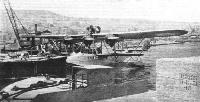
Saro A.7 Severn
В 1928 году выполнила первый полет летающая лодка с экспериментальным облегченным корпусом Supermarine Southampton. Под обозначением A.14 аналогичную лодку спроектировала и построила компания «Saro». Успешные испытания позволили в 1930 году разработать улучшенный вариант Saro A.7 Severn.
Характеристики полутороплана A.7 Severn оказались лучше, чем у двухмоторной Southampton, и были сопоставимы с данными трехмоторной Southampton X. Однако ВМС традиционно предпочитали изделие компании «Supermarine», поэтому заказов на A.7 не последовало.
Описание:
- Saro A.7 Severn
- Flight, January 1931
THE SAUNDERS-ROE A 7 FLYING BOAT - Flight, November 1932
British Aircraft
Фотографии
-
Aeroplane Monthly 1995-08 / P.London - Unlucky Severn
Регистрационный номер: N240 [11] Another taxying shot of N240 shows the later horn-balanced elevators and the servo-rudders on outriggers.
-
Aeroplane Monthly 1995-08 / P.London - Unlucky Severn
Регистрационный номер: N240 [11] The Severn taxying at speed during early trials, before horn-balances had been added to the elevators.
-
Aeroplane Monthly 1995-08 / P.London - Unlucky Severn
Регистрационный номер: N240 [11] N240 taxying under the power of its three Bristol Jupiter engines.
-
Aeroplane Monthly 1995-08 / P.London - Unlucky Severn
Регистрационный номер: N240 [11] N240 on Lake Timsah in the Canal Zone early in September 1931, during its Middle East cruise. An awning protects the cockpit from the sun, and tackle has been rigged over the port engine, apparently for its removal.
-
Aeroplane Monthly 1995-08 / P.London - Unlucky Severn
Регистрационный номер: N240 [11] The MAEE tests showed that the Severn had good stability on the water and that taxying was clean, even in choppy seas.
-
Aeroplane Monthly 1995-08 / P.London - Unlucky Severn
Регистрационный номер: N240 [11] The A.7 seconds before alighting at Cowes, with its two hull steps in evidence.
-
Flight 1931-01 / Flight
Регистрационный номер: N240 [11] Корпус A-7 мало отличался от корпуса летающей лодки Southampton, но силовая установка состояла из трех моторов Bristol Jupiter IX мощностью по 485 л. с.THE SARO A.7 FLYING BOAT: Designed for open sea reconnaissance work, this machine has a metal hull of the same type of construction as that used in the Saro civil machines: Cloud, Windhover and Cutty Sark. The engines are Bristol "Jupiter IX."
-
Aeroplane Monthly 1995-08 / P.London - Unlucky Severn
Регистрационный номер: N240 [11] The Severn on the point of touchdown on the Solent in the summer of 1930.
-
Flight 1931-10 / Flight
Регистрационный номер: N240 [11] THE SARO A 7 AT ALGIERS: A picturesque view of the R.A.F. flying boat refuelling with Shell aviation spirit at Algiers during its recent cruise to the Near East.
-
Aeroplane Monthly 1995-08 / P.London - Unlucky Severn
Регистрационный номер: N240 [11] The A.7 during its evaluation at the Marine Aircraft Experimental Establishment, Felixstowe, in July 1931. By this time deeper windows had been fitted in the hull and the exhaust system had been modified.
-
Aeroplane Monthly 1995-08 / P.London - Unlucky Severn
Регистрационный номер: N240 [11] N240 under maintenance or modification in the manufacturer’s East Cowes shed at an early stage in its development. It has the early unbalanced elevators and is fitted with underwing bomb racks. Note that its serial number is painted on the underside of the upper mainplane.
- Фотографии










